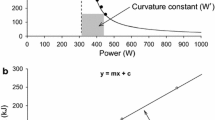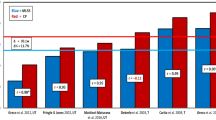Abstract
It has been shown that when three periods of exercise at different intensities are performed to exhaustion, the linear regression of the work accomplished on the time taken defines the critical power (CP) function. The slope of this function is related to endurance ability, whereas the y-intercept is considered to represent anaerobic work capacity (AWC). The purpose of this study was to determine whether two different recovery durations (3 and 24 h), separating three periods of exercise, would elicit differences in the linear CP function. Nine healthy, untrained female students [19.5 (SD 1.6) years] completed five sessions of cycle exercise to exhaustion in random order (familiarisation). Three of these five power outputs were then used in the main part of the study in which the subjects were randomly assigned to two groups. Group one first performed the three power outputs on the same day, with 3 h of passive recovery separating each session (3 on 1). Group two first performed the three power outputs on 3 consecutive days, with approximately 24 h between sessions (3 con). Following 1 day of rest, group one repeated their three power outputs on 3 consecutive days and group two completed their three tests on the same day. Repeated-measures ANOVA revealed no significant differences between the mean values of CP or AWC calculated from the 3 on 1 or 3 con conditions. Trial two estimates of CP were, however, 3.4% (P < 0.05) higher than trial one (familiarisation) estimates. The results of this study showed that reliable measurements of both CP and AWC can be determined from three tests separated by rest periods of 3 h, provided that the subjects are first familiarised with the tests. We found one series of five exercise sessions to be sufficient familiarisation to ensure similar subsequent estimates of CP.
Similar content being viewed by others
References
Boik RJ (1981) A priori tests in repeated measures designs: effects of non-sphericity. Psychometrika 46:241–245
Carnevale TJ, Gaesser GA (1991) Effects of pedalling speed on the power-duration relationship for high-intensity exercise. Med Sci Sports Exerc 23:242–246
DeVries HA, Moritani T, Nagata A, Magnussen K (1982) The relation between critical power and neuromuscular fatigue as estimated from electromyographic data. Ergonomics 25:783–791
Gaesser GA, Wilson LA (1988) Effects of continuous and interval training on the parameters of the power-endurance time relationship for high-intensity exercise. Int J Sports Med 9:417–421
Housh DJ, Housh TJ, Bauge SM (1990) A methodological consideration for determination of critical power and anaerobic work capacity. Res Q Exerc Sport 61:406–409
Housh TJ, deVries HA, Housh DJ, Tichy MW, Smyth KD, Tichy AM, (1991) The relationship between critical power and the onset of blood lactate accumulation. J Sports Med Phys Fitness 31:31–36
Jenkins DG, Quigley BM (1990) Blood lactate in trained cyclists during cycle ergometey at critical power. Eur J Appl Physiol 61:278–283
Jenkins DG, Quigley BM (1991) The y-intercept of the critical power function as a measure of anaerobic work capacity. Ergonomics 34:13–22
Jenkins DG, Quigley BM (1992) Endurance training enhances critical power. Med Sci Sports Exerc 24:1283–289
Jenkins DG, Quigley BM (1993) The influence of high intensity training on theW lim−t lim relationship. Med Sci Sports Exerc 25:275–282
Keppel G (1991) Design and analysis. A researcher's handbook. Prentice-Hall, Sydney
McLellan TM, Cheung KSY (1992) A comparative evaluation of the individual anaerobic threshold and the critical power. Med Sci Sports Exerc 24:543–550
Monod H, Scherrer J (1965) The work capacity of a synergistic muscle group. Ergonomics 8:329–337
Moritani T, Nagata A, DeVries HA, Muro M (1981) Critical power as a measure of physical work capacity and anaerobic threshold. Ergonomics 24:339–350
Nebelsick-Gullett LJ, Housh TJ, Johnson GO, Bauge SM (1988) A comparison between methods of measuring anaerobic work capacity. Ergonomics 31:1413–419
Overand TJ, Cunningham DA, Paterson DH, Smith WDF (1992) Physiological responses of young and elderly men to prolonged exercise at critical power. Eur J Appl Physiol 64:87–193
Poole DC (1986) Letter to the Editor. Med Sci Sports Exerc 18:1265–1279
Poole DC, Ward SA, Whipp BJ (1990) The effects of training on the metabolic and respiratory profile of high-intensity cycle ergometer exercise. Eur J Appl Physiol 59:421–429
Schutz RW, Gessaroli ME (1993) Use, misuse and disuse of psychometrics in sport psychology research. In: Singer RN, Murphey M, Tennant LK, (eds) Handbook of research on sport psychology. Macmillan, New York, pp 901–907
Smith JC, Hill DW (1993) Stability of parameter estimates derived from the power/time relationship. Can J Appl Physiol 18:43–47
Vanderwalle H, Kapitaniak B, Grun S; Raveneau S, Monod H (1989) Comparison between a 30s all out test and a time-work test on a cycle ergometer. Eur J Appl Physiol 58:375–381
Author information
Authors and Affiliations
Rights and permissions
About this article
Cite this article
Bishop, D., Jenkins, D.G. The influence of recovery duration between periods of exercise on the critical power function. Eur J Appl Physiol 72, 115–120 (1995). https://doi.org/10.1007/BF00964125
Accepted:
Issue Date:
DOI: https://doi.org/10.1007/BF00964125




